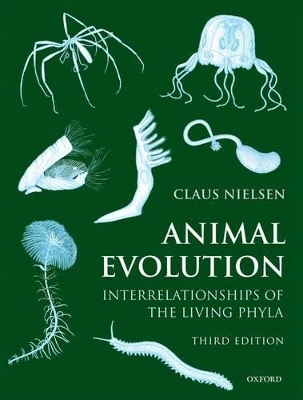
Animal Evolution
Oxford University Press (Verlag)
978-0-19-960603-0 (ISBN)
Animal Evolution provides a comprehensive analysis of the evolutionary interrelationships and myriad diversity of the Animal Kingdom. It reviews the classical, morphological information from structure and embryology, as well as the new data gained from studies using immune stainings of nerves and muscles and blastomere markings which makes it possible to follow the fate of single blastomeres all the way to early organogenesis. Until recently, the information from analyses of gene sequences has tended to produce myriads of quite diverging trees. However, the latest generation of molecular methods, using many genes, expressed sequence tags, and even whole genomes, has brought a new stability to the field. For the first time this book brings together the information from these varied fields, and demonstrates that it is indeed now possible to build a phylogenetic tree from a combination of both morphology and gene sequences.
This thoroughly revised third edition of Animal Evolution brings the subject fully up to date, especially in light of the latest advances in molecular techniques. The book is generously illustrated throughout with finely detailed line drawings and clear diagrams, many of them new.
1. Introduction ; 2. ANIMALIA ; 3. Prelude: Phylum Choanoflagellata ; 4. Early animal radiation ; 5. Phylum Silicea ; 6. EURADICULATA ; 7. Phylum Calcarea ; 8. PROEPITHELIOZOA ; 9. Phylum Homoscleromorpha ; 10. EUMETAZOA (GASTRAEOZOA) ; 11. Phylum Placozoa ; 12. NEURALIA ; 13. Phylum Cnidaria ; 14. TRIPLOBLASTICA ; 15. Phylum Ctenophora ; 16. BILATERIA ; 17. ACOELOMORPHA ; 18. Phylum Acoela ; 19. Phylum Nemertodermatida ; 20. Phylum Xenoturbellida ; 21. EUBILATERIA ; 22. PROTOSTOMIA ; 23. SPIRALIA (LOPHOTROCHOZOA) ; 24. SCHIZOCOELA ; 25. Phylum Annelida ; 26. Phylum Sipuncula ; 27. Phylum Mollusca ; 28. Phylum Nemertini ; 29. Phylum Platyhelminthes ; 30. Phylum Gastrotricha ; 31. GNATHIFERA ; 32. Phylum Gnathostomulida ; 33. Phylum Micrognathozoa ; 34. Phylum Rotifera ; 35. POLYZOA (=Bryozoa s.l.) ; 36. Phylum Entoprocta ; 37. Phylum Cycliophora ; 38. Phylum Bryozoa (=Ectoprocta) ; 39. BRACHIOZOA ; 40. Phylum Phoronida ; 41. Phylum Brachiopoda ; 42. ECDYSOZOA ; 43. PANARTHROPODA ; 44. Phylum Arthropoda ; 45. Phylum Onychophora ; 46. Phylum Tardigrada ; 47. CYCLONEURALIA ; 48. NEMATOIDEA ; 49. Phylum Nematoda ; 50. Phylum Nematomorpha ; 51. SCALIDOPHORA ; 52. Phylum Priapula ; 53. Phylum Kinorhyncha ; 54. Phylum Loricifera ; 55. Phylum Chaetognatha ; 56. DEUTEROSTOMIA ; 57. AMBULACRARIA ; 58. Phylum Echinodermata ; 59. HEMICHORDATA ; 60. Phylum Enteropneusta ; 61. Phylum Pterobranchia ; 62. CHORDATA ; 63. Phylum Cephalochordata ; 64. Phylum Urochordata ; 65. Phylum Vertebrata (Craniata) ; 66. Problematica ; Systematic index ; Subject index
| Erscheint lt. Verlag | 8.12.2011 |
|---|---|
| Zusatzinfo | 100 illustrations plus a colour plate section |
| Verlagsort | Oxford |
| Sprache | englisch |
| Maße | 190 x 245 mm |
| Gewicht | 932 g |
| Themenwelt | Naturwissenschaften ► Biologie ► Evolution |
| Naturwissenschaften ► Biologie ► Genetik / Molekularbiologie | |
| Naturwissenschaften ► Biologie ► Zoologie | |
| ISBN-10 | 0-19-960603-X / 019960603X |
| ISBN-13 | 978-0-19-960603-0 / 9780199606030 |
| Zustand | Neuware |
| Haben Sie eine Frage zum Produkt? |
aus dem Bereich


